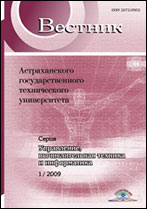|
COMPUTER SOFTWARE AND COMPUTING EQUIPMENT
Memristive biosensors: classification and energy-information model
V. M. Zaripovaa, Yu. A. Lezhninaa, I. Yu. Petrovab, D. M. Gimatdinova
a MIREA – Russian Technological University, Moscow, Russia
b Astrakhan State Technical University,
Astrakhan, Russia
Abstract:
The potential of memristive biosensors as an effective and dynamic link between engineering and biology, providing direct and functional communication for extracting information about biological processes in the human body, is discussed. Memristors can be part of a processing chain and, in the future, combine signal conversion with subsequent processing, acting as intelligent sensors. An energy-informational memristor model describing this nonlinear physical and technical effect and a parametric block diagram for describing such nonlinearity are proposed. To obtain a model of the nonlinear physico-technical effect of a memristor within the framework of the energy-informational model of circuits, a special functional dependence in the “charge-pulse” plane was revealed. It is noted that the memristive effect is observed not only in electrical circuits, but is also described for mechanical, thermal, diffusion, and optical circuits, which are well represented in terms of an energy-informational circuit model. The presented model of the memristive effect will expand the knowledge base of the computer-aided design system by including passports of memristive physical and technical effects. A classification of biosensors based on memristive effects is proposed, which will make it possible to supplement the knowledge bases of the computer-aided design system with passports of memristive physical and technical effects in accordance with this classification and parametric structural schemes of memristive physical and technical effects. The systematization of knowledge based on the identification of the characteristics and features of biosensors, as well as the classification of various types of memristors, will automate the process of choosing the most appropriate type of memristor, taking into account the required characteristics and features of the biosensor, which will lead to an increase in the efficiency of synthesis of new designs of memristive biosensors.
Keywords:
biosensor, memristor, energy information circuits model, physical and technical effect, parametric block diagram.
Received: 29.12.2023
Accepted: 25.01.2024
Citation:
V. M. Zaripova, Yu. A. Lezhnina, I. Yu. Petrova, D. M. Gimatdinov, “Memristive biosensors: classification and energy-information model”, Vestn. Astrakhan State Technical Univ. Ser. Management, Computer Sciences and Informatics, 2024, no. 1, 64–72
Linking options:
https://www.mathnet.ru/eng/vagtu791 https://www.mathnet.ru/eng/vagtu/y2024/i1/p64
|

| Statistics & downloads: |
| Abstract page: | 47 | | Full-text PDF : | 8 | | References: | 10 |
|




 Contact us:
Contact us: Terms of Use
Terms of Use
 Registration to the website
Registration to the website Logotypes
Logotypes








 Citation in format
Citation in format 